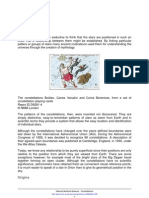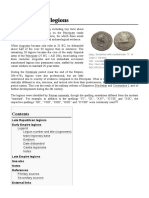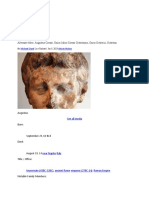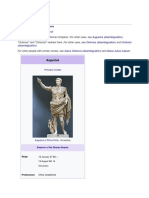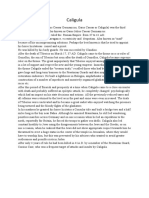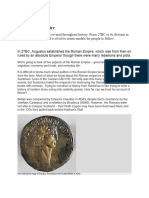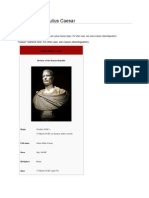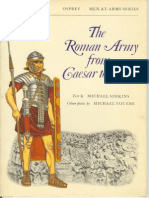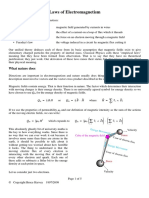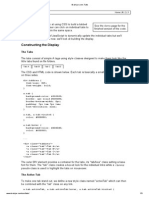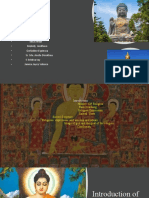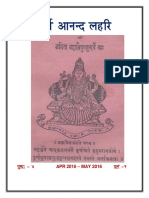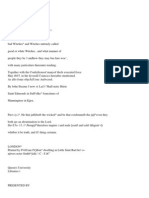Roman Empire Timeline
Roman Empire Timeline
Uploaded by
Sukalyan GhoshalCopyright:
Available Formats
Roman Empire Timeline
Roman Empire Timeline
Uploaded by
Sukalyan GhoshalOriginal Description:
Copyright
Available Formats
Share this document
Did you find this document useful?
Is this content inappropriate?
Copyright:
Available Formats
Roman Empire Timeline
Roman Empire Timeline
Uploaded by
Sukalyan GhoshalCopyright:
Available Formats
Timeline of the Roman Empire - Wikipedia, the free enc...
https://en.wikipedia.org/wiki/Timeline_of_the_Roman...
Timeline of the Roman Empire
From Wikipedia, the free encyclopedia
This not is a timeline of the history of the Roman Empire and only includes important legal and territorial
changes and political events in the Empire from its founding in 27 BC by the Roman Emperor Augustus until the fall in
the West in 476 AD and the transition in the East in 610. To read about the background to these events, see History of
the Roman Empire.
Octavian, great-nephew and adoptive son of Julius Caesar, defeated Roman general Mark Antony and Egyptian Queen
Cleopatra VII at the Battle of Actium in 31 BC, becoming the sole master of the Roman world. After a series of
constitutional settlements between Octavian and the Roman Senate, Octavian was named "Augustus": the rst Roman
Emperor. The Roman Empire, and the successors of Augustus, would rule the ancient world, stretching across three
continents, for almost ve centuries.
Contents
1 United Empire (27 BC to 394 AD)
1.1 Julio-Claudian Dynasty (27 BC to 70 AD)
1.1.1 30s BC
1.1.2 20s BC
1.1.3 10s BC
1.1.4 0s BC
1.1.5 0s AD
1.1.6 10s AD
1.1.7 20s AD
1.1.8 30s AD
1.1.9 40s AD
1.1.10 50s AD
1.1.11 60s AD
1.2 Flavian Dynasty (69 to 96)
1.2.1 60s
1.2.2 70s
1.2.3 80s
1.2.4 90s
1.3 NervaAntonine Dynasty (96 to 192)
1.3.1 90s
1.3.2 100s
1.3.3 110s
1.3.4 120s
1.3.5 130s
1.3.6 140s
1.3.7 150s
1.3.8 160s
1.3.9 170s
1.3.10 180s
1.3.11 190s
1.4 Severan Dynasty (193 to 235)
1.4.1 190s
1.4.2 200s
1.4.3 210s
1.4.4 220s
1.4.5 230s
1.5 Crisis of the Third Century (235 to 285)
1.5.1 230s
1.5.2 240s
1.5.3 250s
1.5.4 260s
1.5.5 270s
1.5.6 280s
1.6 Diocletian and the Tetrarchy (285 to 313)
1.6.1 280s
1.6.2 290s
1.6.3 300s
1.6.4 310s
1.7 Constantinian Dynasty (313 to 363)
1.7.1 320s
1.7.2 330s
1.7.3 340s
1.7.4 350s
1.7.5 360s
1.8 Valentinian Dynasty (364 to 395)
1 of 14
08/11/2015 01:27 PM
Timeline of the Roman Empire - Wikipedia, the free enc...
https://en.wikipedia.org/wiki/Timeline_of_the_Roman...
1.8.1 360s
1.8.2 370s
1.8.3 380s
1.8.4 390s
2 Western Empire (395 to 476)
2.1 Theodosian Dynasty (395 to 455)
2.1.1 390s
2.1.2 400s
2.1.3 410s
2.1.4 420s
2.1.5 430s
2.1.6 440s
2.1.7 450s
2.2 Non-dynastic (455 to 476)
2.2.1 450s
2.2.2 460s
2.2.3 470s
3 Eastern Empire (395 to 1453)
4 See also
United Empire (27 BC to 394 AD)
Julio-Claudian Dynasty (27 BC to 70 AD)
The Julio-Claudian dynasty was a family of ve emperors that governed the Empire during its formative years. All
members of the dynasty drew political power from their family ties to Julius Caesar and Augustus. While members
often acted in despotic manners, the key principle of the dynasty was upholding the Republic facade of the Empire,
known as the Principate, in which the Emperors were not seen as monarchs but as "rst citizen".
1.
2.
3.
4.
5.
Augustus (27 BC14 AD)
Tiberius (1437)
Caligula (3741)
Claudius (4154)
Nero (5468)
30s BC
31 BC - Octavian defeats Marc Antony and the Egyptian Queen Cleopatra VII at the Battle of Actium, becoming
the undisputed master of the Roman world
30 BC - Octavian is named "Pharaoh", annexes Egypt, and bring the Final War of the Roman Republic to a close
20s BC
29 BC Marcus Licinius Crassus, under orders from Octavian, annexes Moesia into the Empire
Octavian begins the Cantabrian Wars to complete the conquest of Hispania
27 BC - Octavian is proclaimed "Augustus" by the Roman Senate and becomes the rst Roman Emperor.
25 BC Marcus Claudius Marcellus, Augustus' nephew by his sister Octavia Minor, is married to Augustus' only
daughter Julia the Elder. Marcellus becomes Augustus' apparent choice as successor.
Following the death of Amyntas of Galatia, a Roman client king, Augustus annexes his kingdom into the
Empire as the province of Galatia.
23 BC - Marcellus dies of illness at age 19, leaving Augustus without clear successor.
21 BC - Marcus Vipsanius Agrippa, Augustus' close friend and chief military commander, is married to Julia the
Elder. Agrippa becomes Augustus' apparent choice as successor.
10s BC
19
17
16
12
BC - The Cantabrian Wars come to an end, completing the Roman conquest of Hispania
BC - Augustus adopts his grandsons by Agrippa and Julia, Gaius Caesar and Lucius Caesar, as his sons
BC - Under orders from Augustus, general Tiberius annexes Raetia and Noricum into the Empire
BC Marcus Vipsanius Agrippa dies of fever at age 51, leaving Augustus without clear successor.
Under orders from Augustus, general Nero Claudius Drusus, step-son of Augustus, crosses the Rhine river
and begins the conquest of Germania
11 BC - Augustus forces his stepson by Livia, the general Tiberius, to divorce his beloved wife Vipsania Agrippina,
a daughter of Agrippa, and to marry his Julia the Elder. Tiberius becomes Augustus' apparent choice as successor.
2 of 14
08/11/2015 01:27 PM
Timeline of the Roman Empire - Wikipedia, the free enc...
https://en.wikipedia.org/wiki/Timeline_of_the_Roman...
0s BC
9 BC Under orders from Augustus, general Tiberius annexes Pannonia into the Empire
Under orders from Augustus, general Nero Claudius Drusus extends Roman domination in Germania to the
Elbe river. Returning to Gaul, Drusus dies from injuries he sustained after falling from his horse.
6 BC - Augustus grants Tiberius tribunican power and military command over the eastern half of the Empire,
guaranteeing his position as Augustus' designated successor. Tiberius, however, retires to the island of Rhodes,
leaving Augustus without a clear heir.
2 BC - Julia the Elder, Augustus' only daughter and wife of Tiberius, is convicted of adultery and treason. Tiberius
divorces her and Augustus exiles her to the island of Pandateria, where she would remain until her death in 14
AD.
0s AD
2 - Lucius Caesar, adoptive son of Augustus and a presumptive heir, dies of illness at age 19. In response,
Augustus allows Tiberius to return from retirement as a private citizen.
4 - Gaius Caesar, adoptive son of Augustus and a presumptive heir, dies of wounds from military campaign at age
24. With no other possible candidate for succession, Augustus adopts his stepson Tiberius as his son and full heir.
Tiberius is made second only to Augustus.
6Augustus deposes Herod Archelaus, Roman client king of Judea, and annexes the kingdom into the Empire as
the province of Judea
The native inhabitants of Illyricum revolt against Roman rule
9Under orders from Augustus, the generals Tiberius and Germanicus crush the Great Illyrian Revolt, restoring
Roman control to the Balkans. Illyricum is divided into the provinces of Pannonia and Dalmatia
General Publius Quinctilius Varus is killed at the Battle of Teutoburg Forest, destroying the Roman army
presence in Germania
10s AD
10 - General Tiberius assumes command of Roman forces in Germania and begins a two-year counterattack
against Germanic tribes
13 - Tiberius returns to Rome, where his powers are made equal to those of Augustus, eectively making him
"Co-Emperor" in all but title.
14 Augustus dies of natural causes at age 75 after a 40-year reign. His step-son and adoptive son Tiberius
becomes Emperor.
Following Augustus' death, soldiers in Germania and Pannonia protested their terms of military service. The
new Emperor Tiberius sends Germanicus, the son of Tiberius' brother Nero Claudius Drusus and Tiberius'
adoptive son, to Germania and sends his biological son Drusus Julius Caesar to Pannonia to put down the
respective revolts.
15 - Sejanus becomes Prefect of the Praetorian Guard and a close advisor to Tiberius.
16 - General Germanicus defeats Germanic tribes at the Battle of Weser River, reasserting Roman domination in
Germania lost after the Battle of Teutoburg Forest
17 Following the death of Archelaus of Cappadocia, a Roman client king, Tiberius annexes Cappadocia into the
Empire
Following the death of Antiochus III of Commagene, a Roman client king, Tiberius annexes Commagene into
the Empire, incorporating its territory into the province of Syria
18 - Tiberius grants Germanicus, who is immensely popular with the Roman people and Tiberius' heir apparent,
military command over the Eastern half of the Empire.
19 - Germanicus dies under mysterious circumstances at the age of 33.
20s AD
22 - Drusus Julius Caesar, Tiberius' son, is granted powers second only to Tiberius, becoming his clear successor.
23 - Drusus dies under mysterious circumstances at the age of 36. Tiberius is left with no clear successor.
26 - Tiberius withdraws to the island of Capri, where he would remain until his death in 37. With Tiberius absent,
Sejanus, Prefect of the Praetorian Guard, is left as de facto ruler of Rome.
29 - Livia, widow of Augustus and mother to Tiberius, dies of natural causes
30s AD
31 Caligula, son of the deceased general Germanicus and Tiberius' grandson by adoption, joins the aging
Emperor on Capri.
On orders of Tiberius, Sejanus is stripped of his ocial position and executed.
35 - Tiberius names Caligula and Tiberius Gemellus, Tiberius' biological grandson, as his joint-heirs
37 - Tiberius dies of natural causes at age 77 after a 23-year reign. His adoptive grandson and designated heir
Caligula becomes Emperor.
38 - Caligula orders Tiberius Gemellus executed for treason
3 of 14
08/11/2015 01:27 PM
Timeline of the Roman Empire - Wikipedia, the free enc...
https://en.wikipedia.org/wiki/Timeline_of_the_Roman...
40s AD
40 - During a state visit to Rome, Ptolemy of Mauretania, Roman client king of Mauretania, is murdered by
Caligula. Mauretania revolts against Roman domination.
41 Caligula sends the general Gaius Suetonius Paulinus to suppress the revolt in Mauretania
Caligula is assassinated by the Praetorian Guard at the age of 28 after a 4-year reign. His uncle Claudius
becomes Emperor
Claudius names Agrippa I as Roman client king of Judea, restoring the province to its status a client kingdom
43 Claudius orders an invasion of Britain, beginning the conquest of the island.
Claudius annexes Lycia into the Empire
44 - General Gaius Suetonius Paulinus crushes the revolt in Mauretania, annexing the kingdom into the Empire.
Claudius divides the territory into the provinces of Mauretania Caesariensis and Mauretania Tingitana
46 - Rhoemetalces III, Roman client king of the Odrysian Kingdom, is assassinated in an anti-Roman revolt.
Claudius suppresses the revolt and annexes the kingdom into the Empire as the province of Thracia
48 Clausius executes his third wife, Valeria Messalina for her countless adulteries and alleged plot to usurp the
throne.
Claudius names Agrippa II as Roman client king of Judea
49 - Claudius marries his niece, Agrippina the Younger (mother of the future Emperor Nero).
50s AD
50 - Claudius adopts Nero, the son of his fourth wife Agrippina the Younger
53 - Claudius accepts Nero as his heir, to the detriment of Britannicus, his son by his third wife Valeria Messalina
54 - Claudius is poisoned by his fourth wife Agrippina the Younger at the age of 63 after a 14-year reign. His
step-son and adoptive son Nero becomes Emperor.
55 - Britannicus dies on the very day before his proclamation as an adult is set, solidifying Nero's claim to the
throne.
58 - War breaks out with Parthia when the Parthians begin a full-scale invasion of the Armenian kingdom.
59 - Nero orders the execution of his mother, Agrippina the Younger.
60s AD
63 - Nero secures a peace deal with Parthia which gains him popularity with the eastern provinces of Rome as
well as with Parthia. Nero's peace would last for 50 years, until Emperor Trajan invades Armenia in 114.
64 The Great Fire of Rome takes place.
Nero begins construction of the Domus Aurea, a lavish entertainment house of 300 rooms with extensive
gold leang and jewel-encrusted ceilings, whose grounds would display a colossal bronze statue of Nero
himself.
65 - Nero discovers a conspiracy against him, organized by Gaius Calpurnius Piso, a Roman Statesman. As a
result, the conspiracy fails, and its members are executed. Among these casualties is Nero's previous advisor,
Seneca, who is ordered to commit suicide after admitting he discussed the plot with the conspirators.
66 - The inhabitants of Judaea revolt against Roman rule, beginning a seven-year war with the Empire. Nero
appoints the general Vespasian to suppress the revolt
68 - Nero, following a revolt by provincial governors and the Praetorian Guard, commits suicide at the age of 30
after a 14-year reign. A civil war begins to determine his successor.
Flavian Dynasty (69 to 96)
The Flavian dynasty rose to power during the civil war of 69, known as the Year of the Four Emperors. Although the
dynasty proved to be short-lived (with three emperors reigning only 27 years), several signicant historic, economic
and military events took place during their reign.
1. Vespasian (69-79)
2. Titus (79-81)
3. Domitian (81-96)
60s
69 - Following the civil war of 68, general Vespasian emerges victorious and is proclaimed by the Senate as
Emperor
70s
70 - As part of the Roman response to the Great Jewish Revolt, the general Titus lays siege to Jerusalem,
destroying the Great Jewish Temple
4 of 14
08/11/2015 01:27 PM
Timeline of the Roman Empire - Wikipedia, the free enc...
https://en.wikipedia.org/wiki/Timeline_of_the_Roman...
73 - Lucilius Bassus, military governor of Judea, lays siege to Masada, ending the Great Jewish Revolt
77 - Gnaeus Julius Agricola is appointed military governor of Britain, consolidates Roman control over the island,
and expands Roman domination into Wales and Scotland
79 Vespasian dies of natural causes at the age of 69 after a 10-year reign. His eldest son, the general Titus,
becomes Emperor
Mount Vesuvius erupts, destroying the Italian cities of Pompeii and Herculaneum
80s
81 - Titus dies of fever at the age of 41 after a 2-year reign. His younger brother Domitian becomes Emperor.
85 - Gnaeus Julius Agricola, military governor of Britain, returns to Rome after successful campaigns in Britain and
its honored by Emperor Domitian.
86 - Dacians under King Decebalus cross the Danube river and invade the Roman province of Moesia, beginning a
two-year war with the Empire
88 - Following a Roman victory against the Dacians at Tapae, the Dacian King Decebalus sues for peace. Domitian
grants favorable terms to Decebalus, with Dacia becoming a Roman client kingdom and receives massive annual
subsidies
89 Lucius Antonius Saturninus, military governor of Germania Superior, revolts against Domitian's rule
Under orders from Domitian, the general Trajan defeats Saturninus and restores imperial control over
Germania Superior
90s
96 - Domitian is assassinated by members of his own court at the age of 44 after a 15-year reign. The Senate
proclaims the elderly Nerva as Emperor
NervaAntonine Dynasty (96 to 192)
The NervaAntonine dynasty were seven Emperors who ruled the Roman Empire from 96 to 192. The dynasty began
when the Senate proclaimed Nerva as Emperor following the assassination of Emperor Domitian. The rst ve of the
six successions within this dynasty were notable in that the reigning Emperor adopted the candidate of his choice to
be his successor. The Emperor Marcus Aurelius would be the only Emperor of this dynasty to be succeeded by his
biological son, the Emperor Commodus. Commodus' assassination would plunge the Empire into a civil war, known as
the Year of the Five Emperors.
1.
2.
3.
4.
5.
6.
7.
Nerva (96-98)
Trajan (98-117)
Hadrian (117-138)
Antoninus Pius (138-161)
Marcus Aurelius (161-180)
Lucius Verus (161-169)
Commodus (180-192)
90s
96 - Following the assassination of Domitian, the Senate proclaims the elderly Nerva as Emperor
97 - Facing military opposition to his reign, Nerva adopts the popular and successful general Trajan as his son and
heir
98 - Nerva dies of natural causes at the age of 67 following a 2-year reign. His adoptive son, the general Trajan,
becomes Emperor without opposition
100s
101 - As part of his conquest of Dacia, Trajan crosses the Danube river and launches an invasion of Dacia,
defeating the Dacian King Decebalus at Tapae
102 - Trajan approves a peace treaty unfavorable to Decebalus, though Dacia remains a Roman client kingdom
105 - Unhappy with his peace treaty with Rome, Dacian King Decebalus crossed the Danube river and raids
Roman cities in Moesia. In response, Trajan crosses the Danube and launches an invasion as part of his conquest
of Dacia,
106 - Defeating the Dacians at the Battle of Sarmisegetusa, Trajan brings his Dacian wars to an end with the
annexation of Dacia into the Empire as a province
107 - Rabbel II Soter, Roman client king of Nabataea, dies. Trajan annexes his kingdom into the Empire as the
province of Arabia Petraea
110s
113 - Trajan begins his invasion of the Parthian Empire
5 of 14
08/11/2015 01:27 PM
Timeline of the Roman Empire - Wikipedia, the free enc...
https://en.wikipedia.org/wiki/Timeline_of_the_Roman...
114 - Trajan deposes Parthamasiris of Armenia, a Roman client king, and annexes his kingdom into the Empire
116 Trajan captures the Parthian capital of Ctesiphon, annexing Mesopotamia and Assyria into the Empire
Trajan deposes King Osroes I of Parthia, installing Parthamaspates of Parthia as his puppet king over the
whole of the Parthian Empire
117 Trajan dies of natural causes at the age of 63 after a 20-year reign. His adoptive son, the general Hadrian,
becomes Emperor
Osroes I of Parthia, the deposed Parthian king, deposes King Parthamaspates of Parthia, reclaiming the
Parthian throne
118 - Hadrian withdraws from the Parthian Empire, returning the recently acquired provinces of Armenia,
Mesopotamia, and Assyria to their status prior to Trajan's war
119 - Hadrian arrives in Britannia to suppress a revolt
120s
122
123
124
126
Construction of Hadrian's Wall in Britannia begins
Hadrian arrives in Mauretania to suppress a revolt
Hadrian arrives in Greece to experience Hellenistic culture
Hadrian returns to Rome and his ordered reconstruction of the Pantheon begins
130s
131 - Hadrian's anti-Jewish policies while in Judea sparks the Bar Kokhba revolt
135 - Hadrian defeats the Bar Kokhba revolt, suppressing Jewish political autonomy and religious freedom,
renaming "Judea" as "Syria Palaestina"
136 - Hadrian names Lucius Aelius Caesar as his adoptive son and heir
138 Lucius Aelius Caesar, Hardian's adoptive son and heir, dies of natural causes
Hadrian names Antoninus Pius as his adoptive son and heir on the condition that he, in turn, adopt Marcus
Aurelius and Lucius Verus as his heirs
Hadrian dies of natural causes at the age of 62 after a 21-year reign. His adoptive son Antoninus Pius
becomes Emperor
140s
150s
160s
161 - Antonius Pius dies of natural causes at the age of 74 after a 23-year reign. His adoptive sons Marcus
Aurelius and Lucius Verus become Co-Emperors
169 - Lucius Verus dies of plague, leaving his adoptive brother Marcus Aurelius as sole Emperor
170s
177 - Marcus Aurelius names his son Commodus as Co-Emperor
180s
180 - Marcus Aurelius dies in Danube War at the age of 58 after a 19-year reign. His son Commodus becomes sole
Emperor
190s
192 - Commodus is assassinated on December 31 by members of his court at the age of 31 after a 15-year reign.
193 - A civil war begins to determine Commodus' successor as Emperor
Severan Dynasty (193 to 235)
The Severan dynasty ruled the Empire between 193 and 235. The dynasty was founded by the general Septimius
Severus, who rose to power as the victor of the civil war of 193, known as the Year of the Five Emperors. Although
Severus successfully restored peace following the upheaval of the late 2nd century, the dynasty was disturbed by
highly unstable family relationships and constant political turmoil.
1. Septimius Severus (193-211)
2. Caracalla (198-217)
6 of 14
08/11/2015 01:27 PM
Timeline of the Roman Empire - Wikipedia, the free enc...
3.
4.
5.
6.
https://en.wikipedia.org/wiki/Timeline_of_the_Roman...
Geta (209-211)
Macrinus (217-218)
Elagabalus (218-222)
Alexander Severus (222-235)
190s
193 - Following the civil war of 193, general Septimius Severus emerges victorious and becomes Emperor
198 - Septimius Severus names his eldest son Caracalla as Co-Emperor
200s
209 - Septimius Severus names his youngest son Geta as Co-Emperor with himself and Caracalla
210s
211 - Septimius Severus dies of natural causes at the age of 65 after an 18-year reign. His sons Caracalla and
Geta rule the Empire jointly as Co-Emperors
211 - Geta is assassinated by his brother Caracalla at the age of 22 after an 11-month reign. Caracalla becomes
sole Emperor
217 - Caracalla is assassinated by members of his bodyguard at the age of 29 after a 19-year reign. His Prefect of
the Praetorian Guard, Macrinus, becomes Emperor
218 - Following a military revolt, Macrinus is executed at the age of 53 after a 13-month reign. Septimius Severus'
great-nephew Elagabalus becomes Emperor
220s
222 - Elagabalus is assassinated by the Praetorian Guard at the age of 18 after a 4-year reign. His cousin
Alexander Severus, another great-nephew of Septimus Severus, is proclaimed Emperor by the Guard.
230s
235 - Following a military revolt, Alexander Severus is assassinated by his own troops at the age of 26 after a
13-year reign. The army proclaims the general Maximinus Thrax as Emperor, beginning a fty-year political and
military crisis.
Crisis of the Third Century (235 to 285)
The Crisis of the Third Century was a period in which the Roman Empire nearly collapsed under the combined
pressures of invasion, civil war, plague, and economic depression. The Crisis began with the assassination of Emperor
Alexander Severus at the hands of his own troops, initiating a fty-year period in which dozens of claimants to the
Imperial throne (with dozens more usurpers and pretenders), mostly prominent Roman Army generals, assumed
imperial power over all or part of the Empire. In 260, the Empire split into three competing states: the western Gallic
Empire, the eastern Palmyrene Empire, and the Roman Empire proper in the center. The Emperor Aurelian reunited the
three states into a single Empire by 274. The Crisis ended with the ascension and reforms of Diocletian.
The Crisis resulted in such profound changes in the Empire's institutions, society, economic life and, eventually,
religion, that it is increasingly seen by most historians as the transition period between the historical periods of
Classical antiquity and late antiquity.
1.
2.
3.
4.
5.
6.
7.
8.
9.
10.
11.
12.
13.
14.
7 of 14
Maximinus Thrax (235-238)
Gordian I (238)
Gordian II (238)
Pupienus and Balbinus (238)
Gordian III (238-244)
Philip the Arab (244-249)
Decius (249-251)
Herennius Etruscus (251)
Trebonianus Gallus (251-253)
Volusianus (251-253)
Aemilian (253)
Valerian (253-260)
Gallienus (253-268)
Claudius Gothicus (268-270)
08/11/2015 01:27 PM
Timeline of the Roman Empire - Wikipedia, the free enc...
15.
16.
17.
18.
19.
20.
21.
https://en.wikipedia.org/wiki/Timeline_of_the_Roman...
Quintillus (270)
Aurelian (270-275)
Marcus Claudius Tacitus (275-276)
Florianus (276)
Probus (276-282)
Carus (282-284)
Carinus (282-285)
230s
235 - Following the assassination of Severus Alexander during a military revolt, the army proclaims Maximinus
Thrax as Emperor
238 - Maximinus Thrax is assassinated in a military revolt at the age of 65 after a 3-year reign. His assassination
results in a civil war to determine his successor:
Gordian I and his son Gordian II become Co-Emperors for one month, ending with a military revolt in which
Gordian II died in battle and Gordian I committing suicide following the military defeat
Pupienus and Balbinus become Co-Emperors for three months, ending with their assassination by the
Praetorian Guard
Gordian III, grandson of Gordian I, is proclaimed Emperor by the Praetorian Guard, ending the civil war of
238
240s
244 - Gordian III dies from unknown causes after a military defeat at the age of 19 after a 6-year reign. His
Prefect of the Praetorian Guard Philip the Arab proclaims himself Emperor.
249 - Following a military revolt, Philip the Arab dies at the age of 45 after a 5-year reign. The general Decius is
proclaimed Emperor by his troops after defeating Philip the Arab in combat
250s
251 - Decius names his son Herennius Etruscus as Co-Emperor.
251 - Decius and Herennius Etruscus are killed in battle by the Goths. Trebonianus Gallus and his son Volusianus
are proclaimed Emperor by the army
253 - In a military revolt, Trebonianus Gallus and son Volusianus are murdered by their own troops. The army
proclaims Aemilian Emperor
253 - In a military revolt, Valerian is proclaimed Emperor by the army. He names his son Gallienus Co-Emperor
260s
260 - Valerian is captured by the Sassanid Empire after a military defeat, becoming a Persian prisoner of war,
ending his 7-year reign. His son Gallienus becomes sole Emperor
260 - The Gallic Empire (the provinces of Britainnia, Hispannia, and Gaul) and the Palmyrene Empire (the
provinces of Syria, Egypt, and Asia) secede from the Empire, becoming separated from Imperial control
268 - In a military revolt, Gallienus is killed at the age of 50 after a 15-year reign. His general Claudius Gothicus is
proclaimed Emperor by the army
270s
270 - Claudius Gothicus dies of illness at the age of 56 after a 2-year reign. His brother Quintillus proclaims
himself Emperor with the support of the Senate while Claudis' general Aurelian is proclaimed Emperor by the
army. Aurelian defeats Quintillus in battle and is recognized as Emperor by the Senate
273 - Aurelian defeats Queen Zenobia, ruler of the Palmyrene Empire, and reunites the eastern provinces into the
Empire
274 - Aurelian defeats Emperor Tetricus I, ruler of the Gallic Empire, and reunites the western provinces into the
Empire
275 - Aurelian is assassinated by the Praetorian Guard at the age of 60 after a 5-year reign. The Senate elects,
with ratication by the army, Marcus Claudius Tacitus as Emperor
276 - Marcus Claudius Tacitus dies of fever at the age of 76 after a 9-month reign. His Prefect of the Praetorian
Guard, Florianus, is proclaimed Emperor by the army
276 - In a military revolt, Florianus is assassinated by his own troops after a 3-month reign. Marcus Aurelius
Probus, former Emperor Tacitus' half-brother, is proclaimed Emperor by the army
280s
282 - In a military revolt, Probus is assassinated by his own troops at the age of 50 after a 6-year reign. His
Prefect of the Praetorian Guard, Carus, is proclaimed Emperor by the army. Carus names his sons Carinus and
Numerian as junior Emperors, with Carinus in the West and Numerian in the East.
283 - Carus dies of natural causes at the age of 59 after a 1-year reign. His son Carinus and Numerian become
Co-Emperors
284 - Numerian dies of disease while on military campaign, allowing his older brother Carinus to become sole
Emperor
284 - Diocletian begins a revolt against Carinus, proclaiming himself Emperor with the support of the Eastern
army.
8 of 14
08/11/2015 01:27 PM
Timeline of the Roman Empire - Wikipedia, the free enc...
https://en.wikipedia.org/wiki/Timeline_of_the_Roman...
285 - Diocletian defeats Carinus in battle, with Carinus killed by his own troops. Diocletian is proclaimed Emperor
by both the western and the eastern armies. The fty-year military and political crisis comes to an end.
Diocletian and the Tetrarchy (285 to 313)
When Diocletian was proclaimed Emperor, he ruled the entire Empire as sole Emperor. Diocletian named Maximian as
his Co-Emperor in 286, through Diocletian remained the senior partner. He then established a system for governing
the Empire by four rulers known as the Tetrachy: two Senior Emperors (Augustii) and two Junior Emperors (Caesars'),
with one Senior and Junior Emperor (the designated heir) in the West and East respectively. Diocletian, and his
successors, become Senior Emperor of the East and Maximian, and his successors, Senior Emperor in the West. The
Tetrachy was relatively stable until the death Constantius Chlorus in 306, which started a civil war to determine the
true successor to the Western throne. The Tetrarchy system ended in 313 with the death of Eastern Emperor
Maximinus II, when internecine conict eliminated most of the claimants to power, leaving Constantius' son
Constantine I as Western Emperor and Licinius as Eastern Emperor.
1.
2.
3.
4.
5.
6.
7.
8.
9.
Diocletian (285-305)
Maximian (286-305)
Galerius (305-311)
Constantius Chlorus (305-306)
Flavius Valerius Severus (306-307)
Constantine the Great (307-337)
Maxentius (307-312)
Maximinus II (310-313)
Licinius (313-324)
280s
285 - Diocletian defeats Carinus in military combat, ending a fty-year military and political crisis and becomes
sole Emperor
285 - Diocletian appoints Maximian as "Caesar" and Junior Emperor
286 - Diocletian elevates Maximian to "Augustus" and Co-Emperor, with Diocletian as Eastern Emperor and Senior
Emperor and Maximian as Western Emperor
290s
293 - With Diocletian's blessing, Constantius Chlorus is appointed by Maximian as "Caesar" and Junior Emperor in
the West.
293 - Diocletian appoints Galerius as "Caesar" and Junior Emperor in the East.
300s
304 - Galerius convinces Diocletian to designte Galeriuss nominees Flavius Valerius Severus and Maximinus II as
"Caesars" upon Constantius Chlorus and Galerius elevation to "Augustii".
305 - Diocletian and Maximian retire simultaneously from their Imperial thrones. Constantius Chlorus becomes
"Augustus" and Senior Emperor in the West and Galerius becomes "Augustus" and Senior Emperor in the East.
Severus becomes "Caesar" and Junior Emperor in the West and Maximinus II becomes "Caesar" and Junior
Emperor in the East.
306 - Constantius Chlorus dies of natural causes at the age of 56 while on military campaign in Britannia. He
convinces his army to proclaim his son Constantine his successor as "Augustus" of the West instead of the
"Caesar" Severus.
306 - Eastern "Augustus" Galerius recognizes Constantine as "Caesar" in the West and elevates Severus to
"Augustus" of the West
306 - Maxentius, son of the former Western "Augustus" Maximian, rebels against the legitimate Western
"Augustus" Severus
307 - Severus is defeated and killed by the usurper Maxentius, who assumes the title "Augustus" of the West
308 - Eastern "Augustus" Galerius rearms Constantine as Western "Caesar" and appoints Licinius as Western
"Augustus" with instructions to defeat the usurper Maxentius
309 - The former Western "Augustus" Maximian and his son the usurper Maxentius have a falling out, with
Maximian eeing to the protection of Constantine
310s
310 - Following a failed revolt against Constantine, the former Western "Augustus" Maximian commits suicide
311 - Eastern "Augustus" Galerius dies of natural causes at the age of 51. His nephew and the Eastern "Caesar"
Maximinus II succeeds him as Eastern "Augustus"
9 of 14
08/11/2015 01:27 PM
Timeline of the Roman Empire - Wikipedia, the free enc...
https://en.wikipedia.org/wiki/Timeline_of_the_Roman...
311 - Maximinus II, the Eastern "Augustus", and Licinius, the Western "Augustus", enter a power-sharing
agreement, both becoming Co-Emperors of the East
311 - Constantine and Licinius declare an alliance through the marriage of Licinius to Constantine's half-sister
Flavia Julia Constantia
311 - Following the alliance of Constantine and Licinius, Maximinus II enters a secret alliance with the usurper
Maxentius
312 - Constantine defeats and kills the usurper Maxentius, becoming undisputed Western Emperor. Following his
victory, Constantine converts to Christianity
313 - Licinius defeats his Co-Eastern Emperor Maximinus II, becoming undisputed Eastern Emperor
Constantinian Dynasty (313 to 363)
1.
2.
3.
4.
5.
6.
7.
Constantine the Great (313-337)
Licinius (313-324)
Constantine II (337-340)
Constantius II (337-361)
Constans (337-350)
Julian the Apostate (360-363)
Jovian (363-364)
320s
324 - Constantine I defeats Licinius in battle and becomes sole Emperor
330s
337 - Constantine I dies of natural causes at the age of 65 after a 31-year reign. His sons Constantine II,
Constantius II, and Constans become Co-Emperors and divide the Empire among themselves:
Constantine II rules the provinces of Britannia, Hispannia, Gaul, and Illyria
Constantius II rules the provinces of Asia, Syria, and Egypt
Constans rules the provinces of Italy and Africa, with Constans placed under the guardianship of Constantine
II
338 - Constans, unhappy with the division of power, petitions his brothers to redivide the Empire, with Constans
receiving Illyria from Constantine II
340s
340 - Despite Constans reaching adulthood, Constantine II refuses to relinquish guardianship over his younger
brother. Constantine II marches to Italy to enforce his authority, where he is defeated in battle by Constans, who
assumes control over his deceased brother's territory.
350s
350 - In a military revolt led by the usurper Magnentius, Constans is murdered by his own troops at the age of 27
after a 14-year reign.
353 - Constantius II defeats the usurper Magnentius in battle and becomes sole Emperor
360s
360 - Julian the Apostate is proclaimed Emperor by the western army
361 - Constantius II dies of natural causes at the age of 44 after a 24-year reign, averting a civil war with Julian.
Constantius' will names Julian as his lawful successor, making Julian sole Emperor
363 - While campaigning against the Sassanid Persians, Julian as mortally wounded in battle and dies at the age
of 31. The commander of his Imperial Guard, Jovian is proclaimed Emperor by the army
364 - Following the signing of a peace treaty with the Persians on humiliating terms, Jovian dies under mysterious
circumstances. The army proclaims the general Valentinian I as Emperor
Valentinian Dynasty (364 to 395)
1. Valentinian I (364-375)
2. Valens (364-378)
10 of 14
08/11/2015 01:27 PM
Timeline of the Roman Empire - Wikipedia, the free enc...
https://en.wikipedia.org/wiki/Timeline_of_the_Roman...
3. Gratian (375-383)
4. Valentinian II (375-392)
5. Theodosius I (378-395)
360s
364 - Following the mysterious death of Jovian, the army proclaims Valentinian I as Emperor. To prevent a
succession crisis, Valentinian I appoints his younger brother Co-Emperor, with Valentinian I as Western Emperor
and Valens as Eastern Emperor
370s
375 - Valentinian I dies of a stroke at the age of 54 following a 12-year reign. His sons Gratian and Valentinian II
succeed him as Co-Emperors of the West
376 - Fleeing Hunnic aggression, the Goths under the leadership of Fritigern cross the Danube River and enter the
Eastern Empire as political refugees
377 - Following harsh treatment by the Romans, the Goths revolt and begin the Gothic War
378 Eastern Emperor Valens is killed in battle by the Goths during the Battle of Adrianople at the age of 50 after
a 15-year reign.
The Western Emperor Gratian names the general Theodosius I as Eastern Emperor
380s
382 - Following a joint east-west military campaign, the Goths and the Empire conclude a peace treaty in which
the Goths are allowed to settle along the southern Danube frontier in the province of Thrace and are granted
signicant self-governance
383 - In a military revolt, Gratian is murdered by his own troops at the age of 24 after an 8-year reign. His half
brother Valentinian II becomes sole Western Emperor
390s
392 - Valentinian II dies under mysterious circumstances (either suicide or murder) at the age of 21 after a
17-year reign. Eastern Emperor Theodosius becomes sole Emperor
395 - Theodosius dies of illness at the age of 48 following a 16-year reign. Theodosius' death permanently divides
the Empire into Western and Eastern halves, with his oldest son Arcadius as Eastern Empire and youngest son
Honorius as Western Emperor.
Western Empire (395 to 476)
The Western Roman Empire existed intermittently in several periods between the 3rd and 5th centuries, after Emperor
Diocletian's Tetrarchy and then after the reunications associated with Emperors Constantine the Great and Julian the
Apostate. Emperor Theodosius I was the last Emperor to rule over an unied Empire. After his death in 395, the Empire
was permanently divided into Eastern and Western halves. Following the nal division, the Western Empire would
survive for eight decades under increased barbarian invasions, eventually falling under the pressure of internal revolt
and foreign invasion in the mid-5th century.
Theodosian Dynasty (395 to 455)
The Theodosian dynasty ruled the Western Empire for fty years. Following the death of Emperor Theodosius I in 395
and the permanent division of the Empire, Theodosius' eleven-year-old son Honorius became Western Emperor. The
Emperor Honorius named Constantius III the Supreme Commander of the Western Army and husband of the Emperor's
sister Galla Placidia, as Co-Emperor in 421. He reigned alongside Honorius briey until he died suddenly after only
seven months as Emperor. Following Honorius' death in the rst quarter of the 5th century, a brief interim existed
during which the Western throne remained legally vacant, though usurpers attempted to claim the throne. Supported
by the Eastern court, six-year-old Valentinian III, the son of Constantius and Placidia, became Emperor. Both members
of the Theodosian dynasty were mostly ceremonial gureheads as both Emperors were dominated by powerful military
commanders, who were the power behind the throne in the West.
1. Honorius (395-423)
2. Constantius III (421)
3. Valentinian III (425-455)
390s
395 Following the death of Emperor Theodosius I, the Western and Eastern halves of the Empire are divided with
Theodosius ten-year-old son Honorius becoming Emperor in the West
11 of 14
08/11/2015 01:27 PM
Timeline of the Roman Empire - Wikipedia, the free enc...
https://en.wikipedia.org/wiki/Timeline_of_the_Roman...
Given Honorius' young age (11 at the time), the Supreme Commander of the Western Army, the half-Vandal
Stilicho, becomes the Emperor's regent and power behind the throne
398 - Supreme Commander Stilicho puts down the Gildonic revolt led by Count of Africa Gildo to defect to the
Eastern Empire.
400s
402 - The capital of the Western Empire moves from Milan to Ravenna
406 - On New Year's Eve, the Vandals, Alans, and Suebi cross the frozen Rhine River and invade the Empire
through Gaul
410s
410 Following failed negotiations with the Western Emperor Honorius, the Visigoths under Alaric I sack Rome, the
rst time the City had been sacked since 384 BC by the Gauls.
The last Roman military forces leave Britain, completing the Roman withdrawal from the island
420s
421 Honorius names the Supreme Commander of the Western Army Constantius III as his Co-Emperor
After only seven months as Co-Emperor, Constantius III dies suddenly
423 - Honorius dies of edema at the age of 39 after a 28-year reign. With no heir to the Western throne, the West
experiences an interregnum in which the usurper Joannes takes power in Rome
424 - Eastern Emperor Theodosius II names his cousin Valentinian III, son of Galla Placidia and Constantius III, as
Western Emperor
425 - The usurper Joannes is defeated by Eastern General Aspar, who installs the six year-old Valentinian III as
Western Emperor. Due to his minority status, the Emperor's mother Placidia becomes his de facto regent as the
true power behind the throne.
430s
440s
450s
455 - Upon the orders of Senator Petronius Maximus, Valentinian III is assassinated in Rome at the age of 35 after
a 29-year reign.
Non-dynastic (455 to 476)
Following the assassination of the Valentinian III, the western branch of the Theodosian dynasty ended. The nal 21
years of the Western Empire would witness the imperial throne change hands nine times with a two-year interregnum,
with each Emperor ruling on average a little over two years each. The central gure during the nal two decades of
the West was the Supreme Commander of the Western Army Ricimer who, despite being unqualied to hold the tile
"Emperor" himself due to his barbarian heritage, eectively ruled the Western Empire for sixteen years as the power
behind the throne. He routinely elevates and deposed a series of puppet Emperors. The Eastern Empire attempted to
restore stability to the West, twice sending an Eastern-backed Emperor to claim the Western throne. The last
legitimate Western Emperor was Julius Nepos, who was sent by Eastern Emperor Zeno. Despite initial success, Julius
Nepos was deposed by his own general, who in turn appointed his son, the child Romulus Augustulus, as Western
Emperor. Romulus Augustus, who was never recognized as Emperor by the East, was forced to abdicate following a
barbarian revolt on September 4, 476. The Senate then sent Eastern Emperor Zeno the Western regalia, legally ending
the separate Western Empire.
1.
2.
3.
4.
5.
6.
7.
8.
9.
Petronius Maximus (455)
Avitus (455-456)
Majorian (457-461)
Libius Severus (461-465)
Anthemius (467-472)
Olybrius (472)
Glycerius (473-474)
Julius Nepos (474-475)
Romulus Augustus (475-476)
450s
12 of 14
08/11/2015 01:27 PM
Timeline of the Roman Empire - Wikipedia, the free enc...
https://en.wikipedia.org/wiki/Timeline_of_the_Roman...
455 - Following his assassination of Valentinian III, Senator Petronius Maximus is declared Emperor by the Senate,
through the Eastern Emperor refuses to recognize his positions and considers him a usurper
455 - After a two-month reign, Maximus Petronius is deposed by an angry mob who stoned him to death as he
attempted to ee Rome as the Vandal's advanced on the City
455 - The Vandals under King Geiseric sack the City of Rome
455 - Upon hearing of the deposition of Petronius, Visigothic King Theodoric II proclaims General Avitus as
Western Emperor.
456 - In a military rebellion led by Count of the Imperial Guard Majorian and Supreme Commander of the Western
Army Ricimer, Avitus is deposed and forced into exile after a fteen-month reign
457 - Following his appointment as General of the Western Army by the Eastern Emperor Leo I, Majorian is
proclaimed Western Emperor by the Western Army and is begrudgingly recognized as such by the Eastern
Emperor
460s
461 - Majorian is deposed and murdered by Ricimer at the age of 40 following a four-year reign. Ricimer waited
three months before installing the weak Senator Libius Severus as his puppet Western Emperor. The new emperor
was not recognized by the Eastern Emperor Leo I, nor by any of the generals who had served under Majorian.
465 - Libius Severus dies of natural causes at the age of 45 following a four-year reign. Ricimer proceeds to rule
the Western Empire without an Emperor.
467 - Under increased assault from the Vandals, Eastern Emperor Leo, with the consent of Ricimer, names the
Eastern General Anthemius as Western Emperor. Anthemius leads an Eastern Army to Italy with orders to
recapture North Africa from the Vandals.
470s
472 In a military revolt lead by Ricimer, Anthemius is killed at the age of 52 following a ve-year reign. Ricimer
names Olybrius as puppet Western Emperor
Ricimer dies of plague at the age of 67 after eectively ruling the Western Empire for sixteen years. His
nephew Gundobad becomes Supreme Commander of the Western Army and the power behind the Western
throne
After only a seven-month reign, Olybrius dies of dropsy at the age of 41. Despite the objections of the
Eastern Emperor Leo I, Gundobad installs Count of the Imperial Guard Glycerius as puppet Western Emperor
473 - Following the death of his father Gondioc (King of the Burgundians), Gundobad abandons his positions as
Supreme Commander of the Western Army to claim his father's vacant throne
474 Eastern Emperor Leo I names the Governor of Dalamtia Julius Nepos as Western Emperor and orders him to
depose the usurper Glycerius
Without the support of Gundobad to protect him, Julius Nepos defeats Glycerius and forces his abdication
and, though unpopular with the Senate due to his family ties to the Eastern Empire, becomes undisputed
Western Emperor
475 Julius Nepos appoints Orestes as Supreme Commander of the Western Army
Orestes, at the head of foederati units, marches on the capital of Ravenna and forces Julius Nepos to ee
Italy for Dalmatia. Though he continued to be recognized as the legitimate Western Emperor by the Eastern
Empire, Juliius Nepos never returned to Italy nor exercised any authority outside of Dalamtia.
Over the objections of the Eastern Emperor Leo I, Orestes names his 12-year-old son Romulus Augustulus as
Western Emperor
476 After refusing to grant land to his foederati units, the foederati units under Odoacer rebell and kill Orestes.
Odoacer advanced to Ravenna, capturing the city and forces Romulus Augustus to abdicate the throne on
September 4, de facto ending the Western Empire
The Senate, at Odoacer's request, sends the Western regalia to the Eastern Emperor Zeno, making Zeno the
de jure Emperor of a reunited Empire. Odoacer de jure rules Italy as Zeno's representative but de facto
exercises independent authority.
Eastern Empire (395 to 1453)
The Eastern Roman Empire was permanently established following the death of Emperor Theodosius I in 395, in which
the united Empire was permanently divided into Eastern and Western halves. The Eastern Empire existed as a
counterpart to the Western Empire until the West's fall in 476. Following the West's fall, the East and West were de jure
reunited as a single Empire. Following the fall of the West, the Eastern Empire would survive for another thousand
years, and is known to modern historiography as the Byzantine Empire. During most of its existence, the East
remained one of the most powerful economic, cultural, and military force in Europe, despite setbacks and territorial
losses, especially during the RomanPersian and RomanArab Wars.
See also
History of Rome
History of the Roman Kingdom
History of the Roman Republic
13 of 14
08/11/2015 01:27 PM
Timeline of the Roman Empire - Wikipedia, the free enc...
https://en.wikipedia.org/wiki/Timeline_of_the_Roman...
History of the Roman Empire
History of the Byzantine Empire
Retrieved from "https://en.wikipedia.org/w/index.php?title=Timeline_of_the_Roman_Empire&oldid=669576661"
Categories: History of the Roman Empire
This page was last modied on 2 July 2015, at 03:15.
Text is available under the Creative Commons Attribution-ShareAlike License; additional terms may apply. By
using this site, you agree to the Terms of Use and Privacy Policy. Wikipedia is a registered trademark of the
Wikimedia Foundation, Inc., a non-prot organization.
14 of 14
08/11/2015 01:27 PM
You might also like
- Diagnostic Test Final Introduction To The Philosophy of The Human PersonDocument4 pagesDiagnostic Test Final Introduction To The Philosophy of The Human Personaljohn anticristo100% (1)
- Republic To Empire TextDocument9 pagesRepublic To Empire Textapi-233464494No ratings yet
- 6th Central Pay Commission Salary CalculatorDocument15 pages6th Central Pay Commission Salary Calculatorrakhonde100% (436)
- Why Must We Fight Tribe Against Tribe?: PlusDocument21 pagesWhy Must We Fight Tribe Against Tribe?: PlusStefan BeemanNo ratings yet
- Queen Elizabeth Died On March 24Document4 pagesQueen Elizabeth Died On March 24Junaid Akram100% (1)
- FCCO Visual Summary Final 2 DigitalDocument45 pagesFCCO Visual Summary Final 2 Digitalj100% (1)
- History of The Roman EmpireDocument14 pagesHistory of The Roman EmpireClaudio MiksicNo ratings yet
- Theories On The Origin of The Solar System: By: Cuerpo, L.And Francisco, ADocument21 pagesTheories On The Origin of The Solar System: By: Cuerpo, L.And Francisco, ARichell G.No ratings yet
- The History of Pannonia Between 54 and 166 ADocument16 pagesThe History of Pannonia Between 54 and 166 AHarisNo ratings yet
- Wadi Al-JarfDocument22 pagesWadi Al-JarfObadele KambonNo ratings yet
- Death of StarsDocument0 pagesDeath of Starshotrdp5483No ratings yet
- Knights of MaltaDocument3 pagesKnights of Maltagljiva7777No ratings yet
- What Happened at Masada PDFDocument18 pagesWhat Happened at Masada PDFiuli67100% (1)
- Ancient History of The Egyptians, Carthaginians, Assyrians, Babylonians, Medes, Persians, Macedonians and Grecians, VOL 2 Rollin 1807Document628 pagesAncient History of The Egyptians, Carthaginians, Assyrians, Babylonians, Medes, Persians, Macedonians and Grecians, VOL 2 Rollin 1807WaterwindNo ratings yet
- History of The United StatesDocument45 pagesHistory of The United Statesdrewzvo100% (1)
- Digital Library of Byzantine Numismatics AxumDocument20 pagesDigital Library of Byzantine Numismatics Axumlm1234567No ratings yet
- Yrus II of Persia (: Modern TiberianDocument2 pagesYrus II of Persia (: Modern TiberiancheloooxxxNo ratings yet
- Origins of Greek Civilization 1100-650 BC (Starr 1961)Document433 pagesOrigins of Greek Civilization 1100-650 BC (Starr 1961)tayl5720100% (2)
- Introduction, Constitutional History & Development, & Salient FeaturesDocument13 pagesIntroduction, Constitutional History & Development, & Salient FeaturesAhmed Ali KhanNo ratings yet
- Onstellations: Patterns in The SkyDocument3 pagesOnstellations: Patterns in The SkyYe MyintNo ratings yet
- Piri Reis ENGDocument10 pagesPiri Reis ENGJoey MartinNo ratings yet
- The Bull Inter CaeteraDocument3 pagesThe Bull Inter CaeteraJason HenryNo ratings yet
- History of The Names of Men, Nations, and PlacesDocument392 pagesHistory of The Names of Men, Nations, and PlacesAndy NicholsNo ratings yet
- The Electrum Coinage of Cyzicus - Greenwell, William, 1820-1918Document156 pagesThe Electrum Coinage of Cyzicus - Greenwell, William, 1820-1918Georgian IonNo ratings yet
- Treasure Is Where You Find It West CanfieldDocument52 pagesTreasure Is Where You Find It West CanfieldClickon DetroitNo ratings yet
- List of Roman LegionsDocument13 pagesList of Roman Legionsnavodi ekanayakaNo ratings yet
- AugustusDocument3 pagesAugustusReZa90No ratings yet
- Summary of Augustus CaesarDocument5 pagesSummary of Augustus CaesarVoid LessNo ratings yet
- Caesar Augustus: The History of the Man Behind the Roman Empire: The Story of Rome, #1From EverandCaesar Augustus: The History of the Man Behind the Roman Empire: The Story of Rome, #1No ratings yet
- Julio ClaudiansDocument48 pagesJulio Claudianslayla.doan336No ratings yet
- Julius CaesarDocument7 pagesJulius Caesarmcdonaldtawoneyi2No ratings yet
- RomeDocument3 pagesRomeEdward Joseph A. RamosNo ratings yet
- Roman Empire - Britannica Online EncyclopediaDocument5 pagesRoman Empire - Britannica Online EncyclopediaEleanor Bertolini0% (1)
- Augustus and The Julio-ClaudiansDocument48 pagesAugustus and The Julio-ClaudiansAnonymous l2sT4aE100% (2)
- AugustusDocument15 pagesAugustusWraith WrathNo ratings yet
- The Rise and Decline of the Roman Empire: The Golden Age of the Empire from Julius Caesar Until Marcus Aurelius & the Period of the Late Empire From the Death of Theodosius I to the Death of JustinianFrom EverandThe Rise and Decline of the Roman Empire: The Golden Age of the Empire from Julius Caesar Until Marcus Aurelius & the Period of the Late Empire From the Death of Theodosius I to the Death of JustinianNo ratings yet
- AugustusDocument5 pagesAugustusgritchard4No ratings yet
- CaligulaDocument5 pagesCaligulaalchemistry5No ratings yet
- ch6 2Document6 pagesch6 2Djordje KrsmanovicNo ratings yet
- KS3 History Year 8and 9Document126 pagesKS3 History Year 8and 9tatianaamani11No ratings yet
- Rome's Enemies Within: Imperial Conspiracies and Assassinations in the Roman Empire during the First Century ADFrom EverandRome's Enemies Within: Imperial Conspiracies and Assassinations in the Roman Empire during the First Century ADNo ratings yet
- Roman EmpireDocument6 pagesRoman Empirezouz3000No ratings yet
- Gaius Julius CaesarDocument33 pagesGaius Julius CaesarMadalina DinuNo ratings yet
- The Lives of the Caesars (Barnes & Noble Library of Essential Reading)From EverandThe Lives of the Caesars (Barnes & Noble Library of Essential Reading)No ratings yet
- Gaius Julius Caesar and Its ExplanationDocument6 pagesGaius Julius Caesar and Its ExplanationSri WirapatniNo ratings yet
- Roman Britain, 43 - 410 AD: The Fall of The Roman RepublicDocument3 pagesRoman Britain, 43 - 410 AD: The Fall of The Roman RepublicAgus RodriguezNo ratings yet
- Greco-Roman (English) : Origins of RomeDocument7 pagesGreco-Roman (English) : Origins of Romejanielle lorin rosalesNo ratings yet
- Osprey Publishing - Roman Army From Caesar To TrajanDocument11 pagesOsprey Publishing - Roman Army From Caesar To Trajanbpayne361No ratings yet
- Creating the Roman Empire: The Lives and Legacies of Julius Caesar and AugustusFrom EverandCreating the Roman Empire: The Lives and Legacies of Julius Caesar and AugustusRating: 5 out of 5 stars5/5 (1)
- Augustus GloopDocument6 pagesAugustus Gloops_bishoymagdyfekryNo ratings yet
- Palatine HillDocument3 pagesPalatine Hillnatia saginashviliNo ratings yet
- Roman Emperors - Their Triumphs and FailuresDocument5 pagesRoman Emperors - Their Triumphs and FailuresVangie OpaoNo ratings yet
- Rome EssayDocument9 pagesRome Essayapi-201219101No ratings yet
- Ad Britannia: First Century Roman Invasion of Britain Book One Ad 23 to 52From EverandAd Britannia: First Century Roman Invasion of Britain Book One Ad 23 to 52No ratings yet
- "Principate" or The Early Roman EmpireDocument6 pages"Principate" or The Early Roman EmpireAisha VermaNo ratings yet
- Ancient Rome: Did You Know? Four Decades After Constantine Made Christianity Rome's Official Religion, EmperorDocument6 pagesAncient Rome: Did You Know? Four Decades After Constantine Made Christianity Rome's Official Religion, EmperorThea Mari MagdasocNo ratings yet
- Alexander The Great (356 - 323 BC)Document35 pagesAlexander The Great (356 - 323 BC)vicky8723No ratings yet
- Julius CaesarDocument2 pagesJulius CaesardocentialbaNo ratings yet
- The Middle Ages: The Surprising History of the Middle Ages for KidsFrom EverandThe Middle Ages: The Surprising History of the Middle Ages for KidsNo ratings yet
- Gandhi On PartitionDocument49 pagesGandhi On PartitionSukalyan GhoshalNo ratings yet
- Laws of ElectromagnetismDocument5 pagesLaws of ElectromagnetismSukalyan GhoshalNo ratings yet
- Madness in The Realm - Narratives of Mental Illness in Late Medieval FranceDocument321 pagesMadness in The Realm - Narratives of Mental Illness in Late Medieval FranceSukalyan GhoshalNo ratings yet
- TA 101 - Official Introduction To Transactional AnalysisDocument23 pagesTA 101 - Official Introduction To Transactional AnalysisSukalyan Ghoshal100% (2)
- Zaps and Traps From The Sicilian DefenseDocument1 pageZaps and Traps From The Sicilian DefenseSukalyan GhoshalNo ratings yet
- Nicad and Lead Acid BatteriesDocument2 pagesNicad and Lead Acid BatteriesSukalyan Ghoshal100% (1)
- Sliding Image Panels With CSS3Document19 pagesSliding Image Panels With CSS3Sukalyan GhoshalNo ratings yet
- WiFi - HowToUse - Debian WikiDocument8 pagesWiFi - HowToUse - Debian WikiSukalyan GhoshalNo ratings yet
- Constructing The Display: Home 2 3Document3 pagesConstructing The Display: Home 2 3Sukalyan GhoshalNo ratings yet
- Analytic Number Theory - Lecture Notes Based OnDocument295 pagesAnalytic Number Theory - Lecture Notes Based OnAlfredo Sotelo PejerreyNo ratings yet
- An Introduction To PythonDocument115 pagesAn Introduction To PythonSukalyan GhoshalNo ratings yet
- Adolf HitlerDocument50 pagesAdolf HitlerSukalyan GhoshalNo ratings yet
- English Explanation of The Last Tenth of The QuranDocument195 pagesEnglish Explanation of The Last Tenth of The Quranabd'arrahmanNo ratings yet
- Al Shabaab 2Document24 pagesAl Shabaab 2Chad WhiteheadNo ratings yet
- 09 - Chapter 4 PDFDocument88 pages09 - Chapter 4 PDFMuhammad HassanNo ratings yet
- Analisis PPT Ting 3 - 2020Document37 pagesAnalisis PPT Ting 3 - 2020MD HAIREE BIN OTHMAN MoeNo ratings yet
- Hum 101 Course MapDocument10 pagesHum 101 Course MapLeire JacutanNo ratings yet
- Aztec Gods and GoddessesDocument46 pagesAztec Gods and GoddessesFederica Angelini100% (2)
- Hindu Ast.Document418 pagesHindu Ast.ANANTHPADMANABHAN100% (1)
- Siddhartha Gantama Phil 1100Document4 pagesSiddhartha Gantama Phil 1100api-317278256No ratings yet
- S5R Gestion Financiere PR Nabouk G2Document23 pagesS5R Gestion Financiere PR Nabouk G2Salma ChahraneNo ratings yet
- Moral Dilemmas in Greek Tragedies: A Discussion of Aeschylus's Agamemnon and Sophokles's AntigoneDocument27 pagesMoral Dilemmas in Greek Tragedies: A Discussion of Aeschylus's Agamemnon and Sophokles's AntigoneAreehaNo ratings yet
- Egypt KartografiaDocument13 pagesEgypt KartografiaMiroslava KorekačováNo ratings yet
- 0e2005667 HGCC Church MembershipDocument4 pages0e2005667 HGCC Church Membershipdriver Online 24 JamNo ratings yet
- Cycles of Zion, Begashaw Tekle, MA Ge'ez LanguageDocument6 pagesCycles of Zion, Begashaw Tekle, MA Ge'ez LanguageMesfin TekesteNo ratings yet
- Buddahism ReportDocument36 pagesBuddahism Reportlaica andalNo ratings yet
- Sitagsus Bao and You Can Call Her Mother Sitang. M: Nong Wat, Are You Done? Let'S Go!Document5 pagesSitagsus Bao and You Can Call Her Mother Sitang. M: Nong Wat, Are You Done? Let'S Go!luhhh luhhhNo ratings yet
- Megillah 27Document79 pagesMegillah 27Julian Ungar-SargonNo ratings yet
- Desert Magazine 1939 OctoberDocument38 pagesDesert Magazine 1939 Octoberdm1937100% (3)
- Purnanandalahari p4D2 PDFDocument57 pagesPurnanandalahari p4D2 PDFGIRIDHARDATTATRAYDIXNo ratings yet
- What Is Neo-AdvaitaDocument19 pagesWhat Is Neo-Advaitanesko61No ratings yet
- Brosur A Arief StitDocument2 pagesBrosur A Arief Stitfahmi syahidNo ratings yet
- Baba Kesar SinghDocument2 pagesBaba Kesar Singhapi-494144535No ratings yet
- The MessengersandTheirTasksDocument24 pagesThe MessengersandTheirTasksNasrin AktherNo ratings yet
- A Confirmation and Discovery of WitchcraftDocument61 pagesA Confirmation and Discovery of WitchcraftcjckdjcndfNo ratings yet
- Day of The Dead Vs Halloween - Difference and Comparison - DiffenDocument5 pagesDay of The Dead Vs Halloween - Difference and Comparison - DiffenFiliberto ColamoreaNo ratings yet
- (Studies in Feminist Philosophy) Laurie J. Shrage (Editor) - You'Ve Changed - Sex Reassignment and Personal Identity (Studies in Feminist Philosophy) - Oxford University Press, USA (2009)Document231 pages(Studies in Feminist Philosophy) Laurie J. Shrage (Editor) - You'Ve Changed - Sex Reassignment and Personal Identity (Studies in Feminist Philosophy) - Oxford University Press, USA (2009)Pedro MaldonadoNo ratings yet
- Awakening To The InfiniteDocument13 pagesAwakening To The InfiniteOana BaraianNo ratings yet
- El ShaddaiDocument9 pagesEl ShaddaiBea Sapinoso VillanuevaNo ratings yet
- The Month of Lord Shiva - Shravan MassDocument4 pagesThe Month of Lord Shiva - Shravan MassAnkita AdhikariNo ratings yet



















